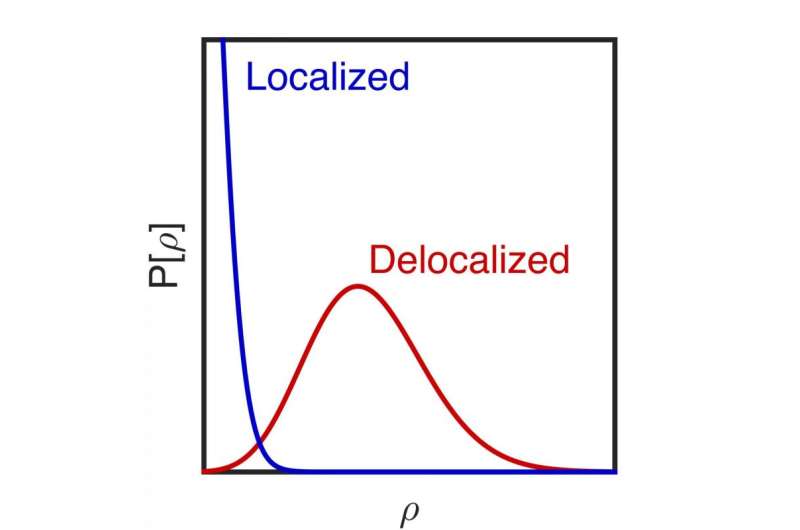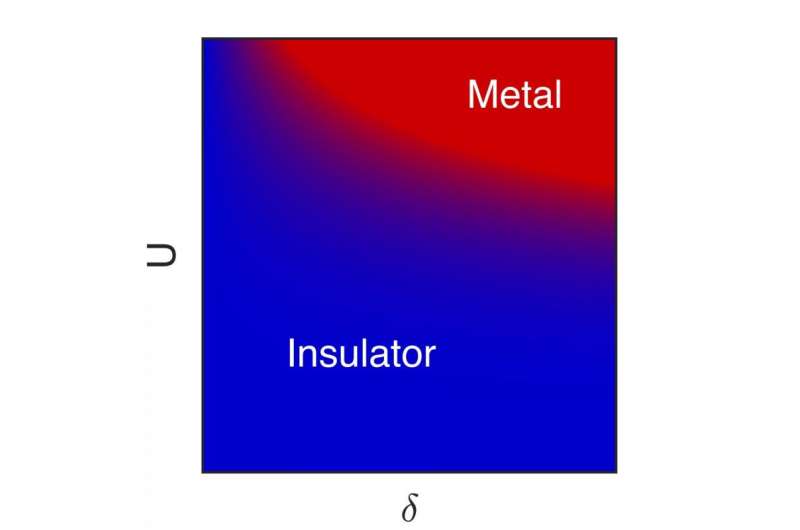Scientists simulate electron localization in real materials

Scientists at the U.S. Naval Research Laboratory (NRL), in collaboration with Florida State University, have developed a method to simulate electron localization in real materials including imperfections and electron-electron interactions.
Electron localization is the tendency of electrons to become confined or clustered in small regions of a material much like humans have a tendency to cluster in cities across the country. Clustering can be caused by local factors such as material imperfections, or as in the case of the Earth, the presence of natural resources, river deltas, or other attractive geographic features.
Another cause for bunching is electron-electron interactions of repulsive Coulomb forces, the strong electrostatic force experienced by charged particles. There is a similar phenomenon among diverse human populations, when aversion or doubt that exists between communities exceeds the mutual benefit of working together and exchanging resources. Just as human migration affects society, electron localization affects material properties such as optical absorption and electron conductivity.
In classical mechanics, the locations of humans, cars, etc., can be tracked, at least in principle. Such tracking is not possible in quantum mechanics, where particle locations are instead given in terms of probability densities. The decay of the electron probability density inside a solid is a measure of electron localization.
"In metals, the electronic states are delocalized, allowing electrons to move from site to site across the material," said Dr. Daniel Gunlycke, head of NRL's Theoretical Chemistry Section. "Imperfections and electron-electron interactions, however, can localize the electronic states, turning a metal into an insulator. It provides us with a mechanism to control the electronic properties and engineer improved functionalities in existing as well as new materials for use in applications ranging from nanoscale optoelectronics to macroscale corrosion prevention."
According to Gunlycke, there is a long history of theoretical research into strong electron localization.

"The majority of this work focuses on localization induced by either imperfections or electron-electron interactions. These limiting cases were predicted by Philip Anderson and Nevill Francis Mott, now known as Anderson and Mott localization, respectively," Gunlycke said. "However, we also know that imperfections and electron-electron interactions can both be considerable in real materials, especially in low-dimensional materials where electronic polarization is generally less effective in reducing the long-range electron-electron Coulomb interactions."
Alongside experiment and theory, computer simulations are essential to develop an understanding of many physical properties in real pristine solids.
"Despite the need, the development of a first-principles-based computational method to characterize electron localization in real materials has been challenging, as imperfections and electron-electron interactions break two of the fundamental assumptions in band theory: material homogeneity and particle independence," said Gunlycke.
In a letter published in Physical Review Letters, March 10 issue, the authors present a new method overcoming these roadblocks by combining first-principles density functional theory, the Anderson-Hubbard model, and the typical medium dynamical cluster approximation within dynamical mean-field theory.
"There is a complex interplay between imperfections and electron-electron interactions in real materials," said Dr. Chinedu Ekuma, a National Research Council (NRC) postdoctoral researcher in Dr. Gunlycke's group. "Computer simulations enabled by our method are expected to reveal new critical insight."
The new method to simulate electron localization in real materials has been applied to monolayer hexagonal boron nitride, a large-gap insulator, and predicts that this is one material that requires both imperfections and electron-electron interactions to undergo an insulator-to-metal transition.
More information: C. E. Ekuma et al. First-Principles-Based Method for Electron Localization: Application to Monolayer Hexagonal Boron Nitride, Physical Review Letters (2017). DOI: 10.1103/PhysRevLett.118.106404
Journal information: Physical Review Letters
Provided by Naval Research Laboratory




















